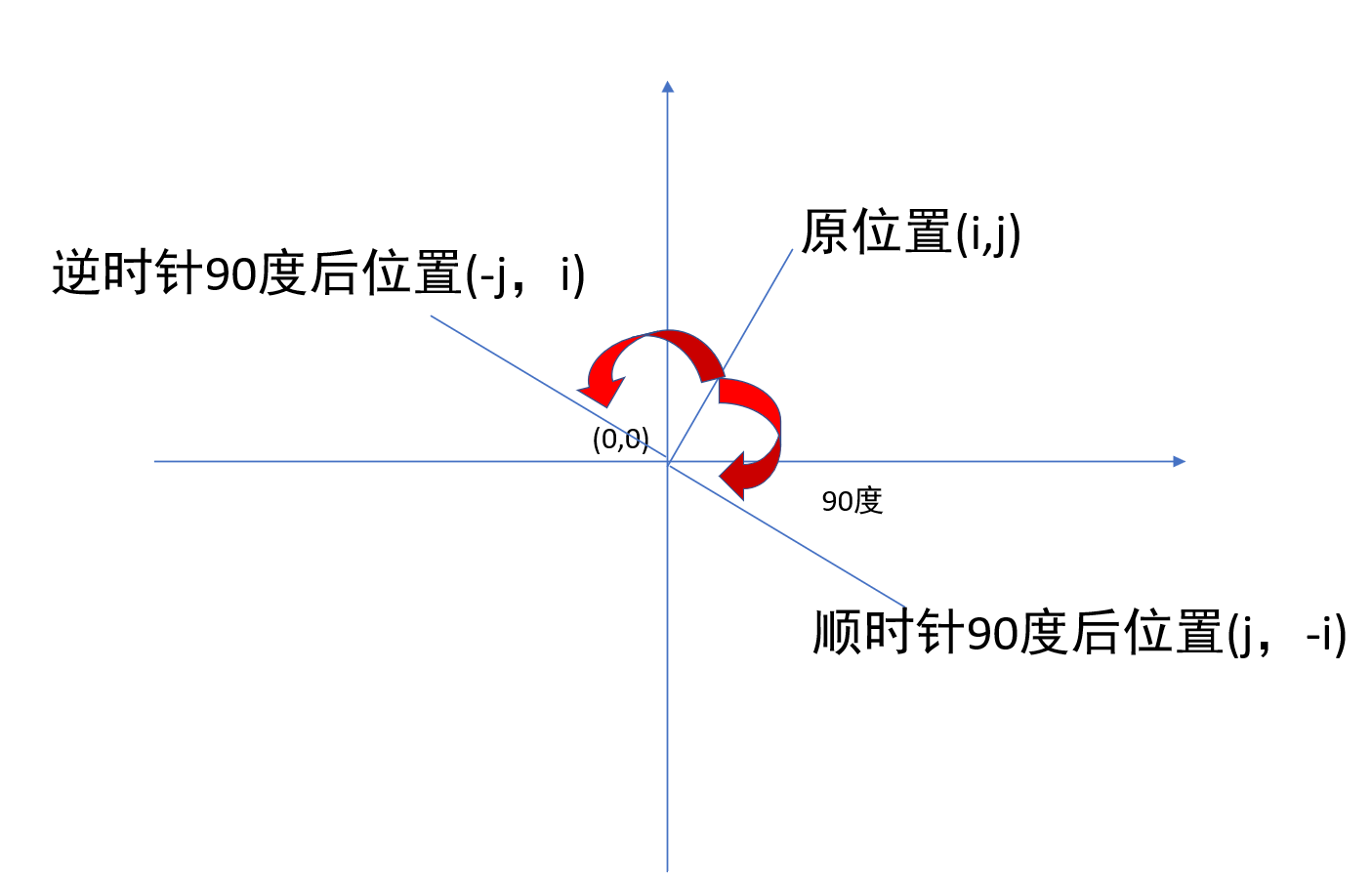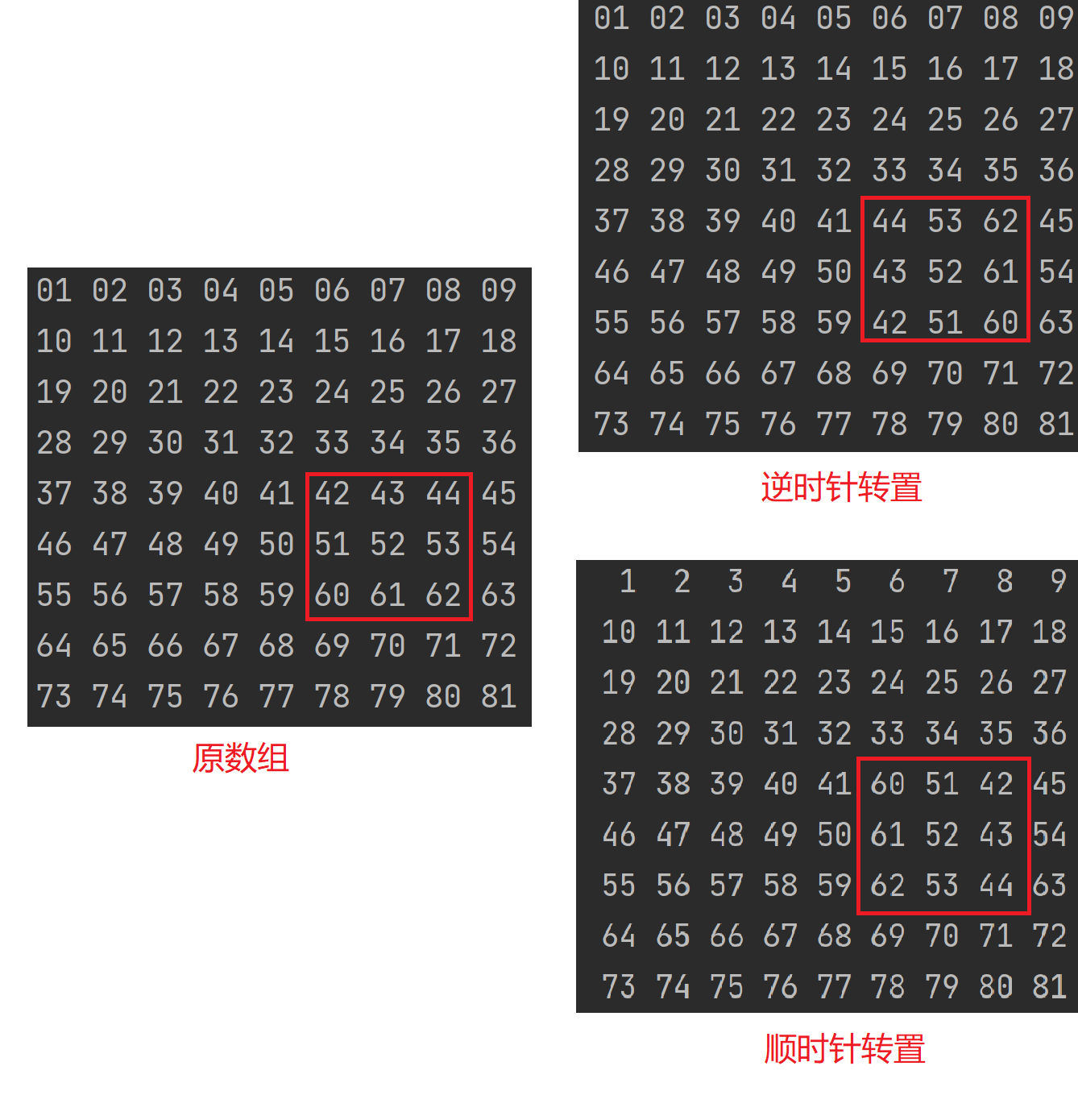2402: 【例】【普及-】【P4924】魔法少女小Scarlet
内存限制:128 MB
时间限制:1.000 S
评测方式:文本比较
命题人:
提交:9
解决:4
题目描述
Scarlet 最近学会了一个数组魔法,她会在 二维数组上将一个奇数阶方阵按照顺时针或者逆时针旋转 。
首先,Scarlet 会把 到 的正整数按照从左往右,从上至下的顺序填入初始的二维数组中,然后她会施放一些简易的魔法。
Scarlet 既不会什么分块特技,也不会什么 Splay 套 Splay,她现在提供给你她的魔法执行顺序,想让你来告诉她魔法按次执行完毕后的二维数组。
输入
第一行两个整数 ,表示方阵大小和魔法施放次数。
接下来 行,每行 个整数 ,表示在这次魔法中,Scarlet 会把以第 行第 列为中心的 阶矩阵按照某种时针方向旋转,其中 表示顺时针, 表示逆时针。
输出
输出 行,每行 个用空格隔开的数,表示最终所得的矩阵
样例输入 复制
5 4
2 2 1 0
3 3 1 1
4 4 1 0
3 3 2 1样例输出 复制
5 10 3 18 15
4 19 8 17 20
1 14 23 24 25
6 9 2 7 22
11 12 13 16 21提示
对于50%的数据,满足
对于100%的数据 ,满足 。
因为矩阵是绕着某个中心旋转的而且保证是正方形,为了得到正确的式子、便于理解,我们不妨设为原点,这样稍微模拟一下就可以得到顺时针旋转90°后正方形上一点坐标变成,逆时针旋转90°后坐标变成,然后枚举即可。

注意:
这里可能有的同学不理解,我们明明在是数组上操作,数组上操作是没有负号的,你上面怎么用直角坐标系来推导?那个负号怎么办啊?
其实,在数组中,我们并不是从这个点为中心的,而是以为中心,就是每个推导的结果在横坐标和纵坐标上要分别加上

#include<bits/stdc++.h>
using namespace std;
const int N = 510;
int n, m;
int x, y, r, z;
int a[N][N], b[N][N];
int cnt;
// 数组b为最后输出的结果数组,a为辅助数组;
int main() {
cin >> n >> m;
for (int i = 1; i <= n; i++)
for (int j = 1; j <= n; j++)
b[i][j] = a[i][j] = ++cnt;
while (m--) {//m次指令
cin >> x >> y >> r >> z;
if (z == 0) { //顺时针
for (int i = -r; i <= r; i++) //i为以(x,y)为中点的偏移量,可以用来描述横坐标
for (int j = -r; j <= r; j++)//j为以(x,y)为中点的偏移量,可以用来描述纵坐标
//防止自己覆盖掉自己,在副本上操作
//遍历每一个范围内的坐标,根据上图,确定最终的坐标
b[x + j][y - i] = a[x + i][y + j];
} else if (z == 1) {//逆时针
for (int i = -r; i <= r; i++)
for (int j = -r; j <= r; j++)
//防止自己覆盖掉自己,在副本上操作
//遍历每一个范围内的坐标,根据上图,确定最终的坐标
b[x - j][y + i] = a[x + i][y + j];
}
for (int i = 1; i <= n; i++) //更新辅助数组
for (int j = 1; j <= n; j++)
a[i][j] = b[i][j];
}
//输出
for (int i = 1; i <= n; i++) {
for (int j = 1; j <= n; j++) cout << b[i][j] << ' ';
cout << endl;
}
return 0;
}